The global Cathode Materials for Solid State Battery market is projected to grow from USD 449.5 million in 2025 to approximately USD 5,604.2 million by 2035, recording an absolute increase of USD 5,154.4 million over the forecast period. This translates into a total growth of 1,146.5%, with the market forecast to expand at a compound annual growth rate (CAGR) of 28.7% between 2025 and 2035. The overall market size is expected to grow by 12.5X during the same period, supported by accelerating demand for next-generation battery technologies in electric vehicle applications, breakthrough advancements in solid-state battery manufacturing processes, and expanding adoption of high-performance cathode materials across automotive manufacturers and energy storage system providers.
The dramatic market expansion reflects the transformative potential of solid-state battery technology in revolutionizing energy storage systems and electric vehicle powertrains. Major automotive manufacturers worldwide are increasingly incorporating advanced cathode materials to enhance battery performance and reduce charging times, while breakthrough developments in lithium iron phosphate and high nickel ternary materials are creating unprecedented demand for specialized cathode compounds that deliver superior energy density and operational stability under demanding thermal conditions.
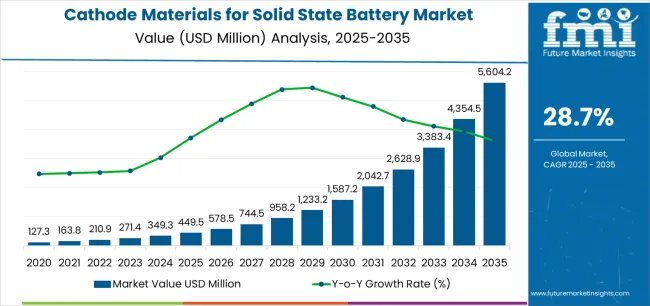
Manufacturing capabilities are advancing rapidly as leading producers invest in precision material synthesis facilities and proprietary coating technologies to meet growing market demand for enhanced cycling stability and reduced degradation rates. The technology landscape continues evolving with innovations in cathode particle engineering, surface modification techniques, and thermal management systems that enhance battery performance while reducing material costs. Battery manufacturers and automotive suppliers are collaborating extensively to develop next-generation cathode materials that address specific performance requirements across electric vehicle applications, portable electronics, and grid-scale energy storage sectors.
Quality standards are becoming increasingly stringent as applications demand higher energy densities and greater safety under extreme operating conditions. Industry certification programs and validation protocols ensure consistent material performance while supporting market confidence in solid-state battery technology adoption across critical automotive applications and regulated energy storage environments. Regulatory compliance requirements for automotive and aerospace applications are driving investments in comprehensive quality management systems and testing protocols throughout the manufacturing supply chain.
International collaboration is accelerating market development as major electric vehicle projects require coordinated efforts between multiple battery manufacturers and cathode material suppliers. Global automotive companies are establishing standardized specifications for cathode material performance that influence worldwide manufacturing standards and create opportunities for specialized suppliers. Battery system engineering firms are forming strategic partnerships with material manufacturers to develop application-specific solutions tailored to emerging electric vehicle technologies and installation requirements.
Investment patterns are shifting toward integrated solution development as major end-users seek comprehensive battery systems that combine cathode materials with advanced monitoring capabilities and predictive maintenance features. Automotive companies are forming joint ventures with material providers to develop customized battery platforms, while energy storage developers are acquiring stakes in specialized cathode manufacturers to ensure access to cutting-edge materials for their production and assembly programs. This trend toward strategic partnerships and technology integration is reshaping competitive dynamics across the battery materials value chain.
Market maturation is evident in the emergence of specialized application segments that demand unique cathode characteristics and performance specifications. Electric vehicle applications require extremely stable performance and thermal resistance under rapid charging and discharging conditions, while consumer electronics need cathode materials that maintain accuracy and reliability when handling high-frequency cycling and power density requirements. These specialized requirements are driving innovation in material compositions, particle morphology, and coating methodologies that extend beyond traditional lithium-ion battery applications.
| Metric | Value |
|---|---|
| Market Value (2025) | USD 449.5 million |
| Market Forecast Value (2035) | USD 5,603.9 million |
| Forecast CAGR (2025-2035) | 28.7% |
| ELECTRIC VEHICLE REVOLUTION | ENERGY STORAGE EXPANSION | TECHNOLOGY ADVANCEMENT |
|---|---|---|
| Automotive Electrification - Global electric vehicle production scaling requiring advanced cathode materials with superior energy density, thermal stability, and rapid charging capabilities for passenger cars, commercial vehicles, and public transportation systems with enhanced performance under diverse operating conditions and extended operational lifespans. | Grid Scale Storage - Utility-scale energy storage systems implementing solid-state battery technology requiring precision cathode materials for renewable energy integration, peak load management, and grid stabilization with exceptional cycling stability and minimal capacity degradation under continuous operation. | Material Innovation - Advanced cathode manufacturing processes developing next-generation compounds with enhanced ionic conductivity, improved structural stability, and reduced production costs through breakthrough synthesis techniques, particle engineering, and surface modification technologies. |
| Commercial Vehicle Adoption - Heavy-duty transportation and logistics companies deploying electric trucks, buses, and delivery vehicles requiring high-performance cathode materials for extended range capabilities, fast charging compatibility, and operational reliability under demanding commercial duty cycles with superior power density characteristics. | Residential Storage Growth - Home energy storage systems and backup power applications requiring compact cathode materials for solar energy integration, power outage protection, and load shifting capabilities with enhanced safety characteristics and simplified maintenance procedures. | Performance Enhancement - Battery manufacturers implementing advanced cathode formulations delivering improved energy retention, faster ion transport, and enhanced thermal management for applications requiring superior power output and extended operational stability. |
| Public Transportation - Urban transit authorities and railway operators implementing electric bus fleets and rail systems requiring specialized cathode materials for traction power supplies, regenerative braking systems, and auxiliary power equipment with exceptional durability under mechanical stress and environmental exposure. | Industrial Applications - Manufacturing facilities and data centers implementing backup power systems requiring reliable cathode materials for uninterruptible power supplies, emergency systems, and critical infrastructure protection with minimal maintenance requirements and consistent performance characteristics. | Manufacturing Scale-Up - Production facilities advancing automated manufacturing processes and quality control systems for cathode material synthesis, processing, and testing with enhanced throughput capabilities and reduced material waste. |
| Category | Segments / Values |
|---|---|
| By Type | Lithium Cobalt Oxide; Lithium Iron Phosphate; High Nickel Ternary Materials; Others |
| By Application | Power Batteries; Consumer Electronics Batteries; Energy Storage Batteries; Others |
| By End-User | Electric Vehicle Manufacturers; Consumer Electronics Companies; Energy Storage Providers; Aerospace & Defense; Others |
| By Voltage Rating | Low Voltage; Medium Voltage; High Voltage; Ultra-High Voltage |
| By Battery Capacity | Below 50 Ah; 50-200 Ah; 200-500 Ah; Above 500 Ah |
| By Distribution Channel | Direct Sales; Material Distributors; Technology Partners; System Integrators |
| By Region | North America; Europe; Asia Pacific; Latin America; Middle East & Africa |
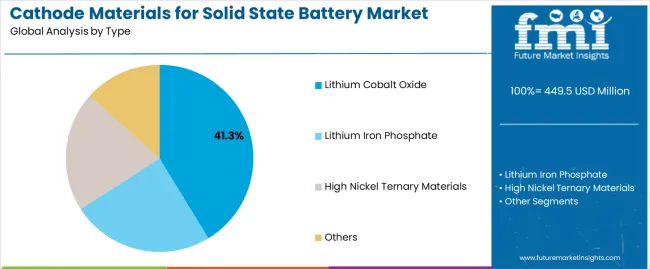
| Segment | 2025-2035 Outlook |
|---|---|
| Lithium Iron Phosphate | Leader in 2025 with 41.3% market share; optimal stability and cost-effectiveness for automotive applications. Widely adopted for electric vehicle powertrains and energy storage systems requiring consistent cycling performance. Momentum: rapid growth across electric vehicle and grid storage segments. Watchouts: competition from high nickel alternatives in premium applications. |
| High Nickel Ternary Materials | Significant segment with 32.7% share, favored for high-energy applications requiring superior power density and extended range capabilities. Momentum: exceptional growth in premium electric vehicles and aerospace applications. Watchouts: thermal management complexity and higher material costs. |
| Lithium Cobalt Oxide | Traditional segment with 18.4% share for consumer electronics requiring compact form factors and reliable performance characteristics. Momentum: steady growth in portable electronics and specialized applications. Watchouts: supply chain constraints and ethical sourcing requirements. |
| Others | Includes advanced phosphate compounds and experimental formulations for specialized applications. Momentum: selective growth in aerospace and industrial applications. |
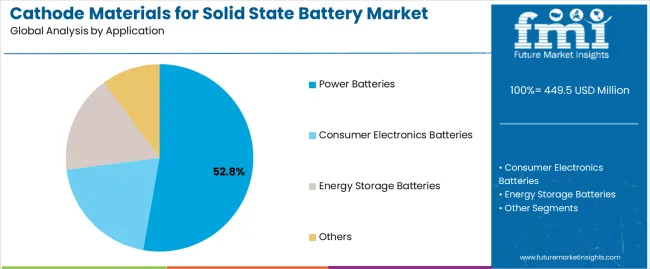
| Segment | 2025-2035 Outlook |
|---|---|
| Power Batteries | Largest application segment in 2025 at 52.8% share, driven by electric vehicle adoption and transportation electrification requiring high-performance cathode materials. Includes automotive powertrains, commercial vehicle systems, and public transportation applications. Momentum: exceptional growth from global electric vehicle expansion and regulatory support. Watchouts: supply chain coordination and manufacturing scale requirements. |
| Energy Storage Batteries | Critical segment representing 28.9% share, experiencing strong growth from grid-scale storage installations and renewable energy integration projects. Momentum: robust growth as utilities implement energy storage systems. Watchouts: cost pressures and long-term reliability requirements. |
| Consumer Electronics Batteries | Growing segment at 15.6% share for smartphones, laptops, and portable devices requiring compact cathode materials with enhanced energy density. Momentum: steady growth from device miniaturization and performance advancement. Watchouts: rapid technology cycles and cost sensitivity. |
| Others | Includes aerospace applications, military systems, and specialized industrial equipment. Momentum: diverse growth opportunities across multiple high-performance sectors. |
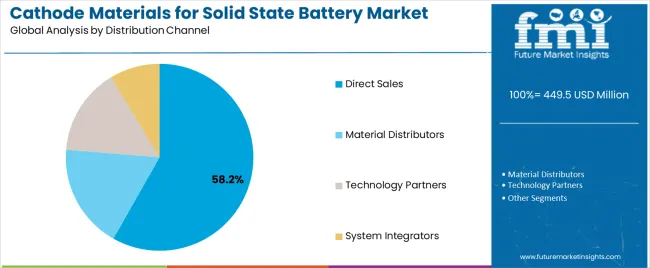
| Distribution Channel | Status & Outlook (2025-2035) |
|---|---|
| Direct Sales | Dominant channel in 2025 with 58.2% share for specialized automotive applications. Provides technical consultation, material engineering, and customized formulations for complex battery projects. Momentum: strong growth driven by electric vehicle programs and energy storage projects requiring direct manufacturer engagement. Watchouts: resource constraints and technical support capacity limitations. |
| Technology Partners | Collaborative channel serving battery manufacturers and system integrators with comprehensive material portfolios and application development capabilities. Momentum: growing importance as battery technology advances accelerate. Watchouts: partnership coordination complexity and intellectual property considerations. |
| Material Distributors | Technical distribution serving smaller battery manufacturers and research institutions with standard material configurations and inventory capabilities. Momentum: moderate growth as market expands beyond core automotive applications. |
| System Integrators | Specialized channel for complete battery system projects with engineering firms and technology specialists. Momentum: strategic growth as electric vehicle and energy storage projects accelerate. |
| DRIVERS | RESTRAINTS | KEY TRENDS |
|---|---|---|
| Electric Vehicle Mandates across automotive markets and government regulations creating substantial demand for advanced cathode materials supporting zero-emission transportation goals, fleet electrification programs, and carbon reduction initiatives requiring superior battery performance and operational reliability. | High Development Costs and complex material synthesis requirements limit accessibility across smaller battery manufacturers and research institutions with limited capital resources for advanced material development and testing infrastructure. | Smart Battery Integration - Advanced cathode materials incorporating monitoring capabilities, diagnostic features, and communication systems for predictive maintenance, performance optimization, and thermal management in next-generation battery applications. |
| Energy Density Requirements - Consumer electronics and automotive applications demanding higher energy storage capabilities driving adoption of advanced cathode formulations delivering superior capacity, power output, and cycling stability for extended device operation and electric vehicle range. | Manufacturing Complexity - Material synthesis procedures, quality control requirements, and specialized processing equipment affecting production timelines and operational capabilities for facilities lacking dedicated battery material engineering resources and certification programs. | Cost Optimization - Innovations in material composition, synthesis processes, and manufacturing techniques delivering enhanced performance characteristics while reducing production costs and material waste through advanced automation and quality control systems. |
| Grid Storage Expansion - Utility companies implementing large-scale energy storage systems for renewable energy integration and grid stabilization requiring reliable cathode materials with exceptional cycling performance and minimal degradation under continuous operation conditions. | Supply Chain Constraints - Raw material availability and processing capacity limitations constraining production scaling among manufacturers lacking established supplier relationships and strategic material reserves for sustained production growth. | Application Diversification - Expanding use cases in aerospace applications, military systems, and industrial equipment creating new market opportunities beyond traditional consumer electronics and automotive applications. |
| Technology Investment - Research and development programs advancing cathode material science through breakthrough innovations in crystal structures, surface modifications, and composite formulations enhancing battery performance while addressing safety and environmental considerations. | Regulatory Compliance - Safety certification requirements and environmental standards create operational complexity and ongoing costs for material manufacturers and battery system producers lacking comprehensive testing and documentation capabilities. | Manufacturing Automation - Advanced production systems implementing automated synthesis, quality control, and packaging processes enabling consistent material properties, reduced manufacturing costs, and enhanced production throughput capabilities. |
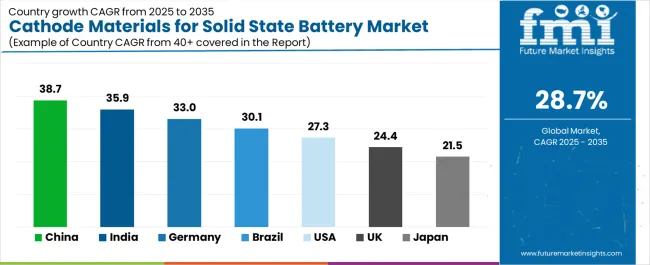
| Country | CAGR (2025-2035) |
|---|---|
| China | 38.7% |
| India | 35.9% |
| Germany | 33.0% |
| Brazil | 30.1% |
| United States | 27.3% |
| United Kingdom | 24.4% |
| Japan | 21.5% |
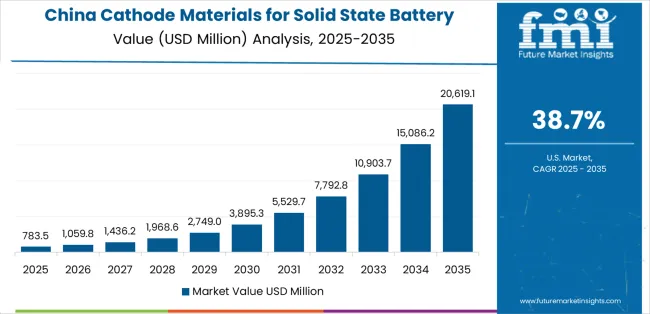
Revenue from Cathode Materials for Solid State Battery in China is projected to exhibit exceptional growth with a market value of USD 2,628.8 million by 2035, driven by massive electric vehicle production expansion and comprehensive battery manufacturing initiatives creating substantial opportunities for cathode material suppliers across automotive powertrains, energy storage systems, and consumer electronics sectors. The country's ambitious electrification programs including national electric vehicle mandates and battery technology development initiatives are creating unprecedented demand for specialized cathode materials. Major automotive manufacturers and battery producers including BYD, CATL, and industrial automation leaders are establishing comprehensive material procurement programs to support large-scale electric vehicle production and advanced energy storage applications.
Revenue from Cathode Materials for Solid State Battery in India is expanding to reach USD 1,587.1 million by 2035, supported by extensive electric vehicle adoption programs and comprehensive battery manufacturing initiatives creating demand for cathode materials across diverse automotive and energy storage application segments. The country's growing electric vehicle capabilities and expanding battery manufacturing infrastructure are driving demand for materials that provide exceptional performance while supporting advanced battery system requirements. Automotive companies and battery facilities are investing in cathode material technology development to support growing electric vehicle demand and energy storage requirements.
Demand for Cathode Materials for Solid State Battery in Germany is projected to reach USD 1,233.2 million by 2035, supported by the country's leadership in automotive technology and advanced battery systems requiring sophisticated cathode materials for electric vehicle applications and energy storage systems. German automotive manufacturers are implementing cutting-edge battery platforms that support advanced performance capabilities, operational precision, and comprehensive safety monitoring protocols. The market is characterized by focus on engineering excellence, technology innovation, and compliance with stringent automotive safety and performance standards.
Revenue from Cathode Materials for Solid State Battery in Brazil is growing to reach USD 958.2 million by 2035, driven by electric vehicle adoption programs and increasing automotive capabilities creating opportunities for cathode material suppliers serving both automotive manufacturers and specialized battery contractors. The country's expanding electric vehicle sector and growing industrial infrastructure are creating demand for materials that support diverse battery requirements while maintaining performance standards. Automotive companies and battery manufacturers are developing technology strategies to support operational efficiency and system reliability advancement.
Demand for Cathode Materials for Solid State Battery in United States is projected to reach USD 744.5 million by 2035, expanding at a CAGR of 27.3%, driven by advanced electric vehicle development and specialized automotive applications supporting battery technology advancement and comprehensive transportation electrification applications. The country's established automotive tradition including major vehicle manufacturers and battery system facilities are creating demand for high-performance cathode materials that support operational advancement and safety standards. Manufacturers and battery system suppliers are maintaining comprehensive development capabilities to support diverse automotive and energy storage requirements.
Revenue from Cathode Materials for Solid State Battery in United Kingdom is growing to reach USD 578.5 million by 2035, supported by automotive technology heritage and established engineering communities driving demand for premium cathode materials across traditional automotive systems and specialized electric vehicle applications. The country's rich automotive engineering heritage including major vehicle manufacturers and established battery system capabilities create demand for materials that support both legacy system advancement and modern electric vehicle applications.
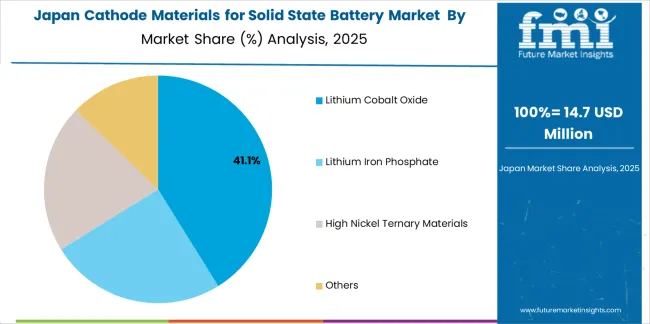
Demand for Cathode Materials for Solid State Battery in Japan is projected to reach USD 449.5 million by 2035, driven by precision battery technology tradition and established manufacturing leadership supporting both domestic automotive markets and export-oriented material production. Japanese companies maintain sophisticated cathode material development capabilities, with established manufacturers continuing to lead in battery technology and material standards.
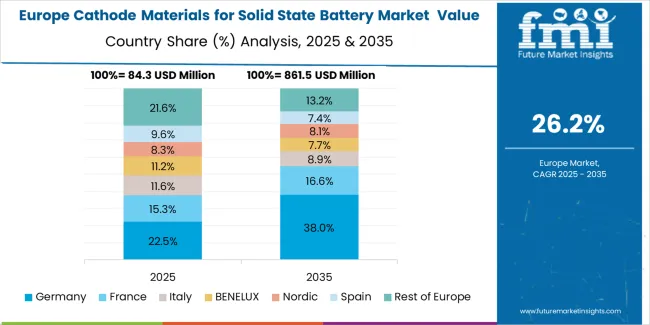
European Cathode Materials for Solid State Battery operations are increasingly concentrated between German automotive excellence and specialized manufacturing across multiple countries. German facilities dominate high-performance material production for electric vehicle applications and energy storage systems, leveraging cutting-edge synthesis technologies and strict quality protocols that command price premiums in global markets. British automotive operators maintain leadership in battery technology development and material specification advancement, with organizations like automotive research centers and university programs driving technical specifications that suppliers must meet to access major vehicle manufacturer contracts.
Eastern European operations in Czech Republic and Poland are capturing specialized production contracts through precision manufacturing expertise and EU compliance standards, particularly in material synthesis and processing technologies for automotive applications. These facilities increasingly serve as development partners for Western European automotive programs while building their own battery technology expertise.
The regulatory environment presents both opportunities and constraints. European automotive safety framework requirements create quality standards that favor established European manufacturers and automotive operators while ensuring consistent performance specifications for critical transportation and energy storage applications. Brexit has created complexity for UK automotive collaboration with EU programs, driving opportunities for direct relationships between British operators and international cathode material suppliers.
Technology collaboration accelerates as automotive companies seek material advancement to support major electric vehicle milestones and battery technology timelines. Vertical integration increases, with major automotive operators acquiring specialized manufacturing capabilities to secure material supplies and quality control for critical vehicle programs. Smaller battery contractors face pressure to specialize in niche applications or risk displacement by larger, more comprehensive operations serving mainstream automotive and energy storage requirements.
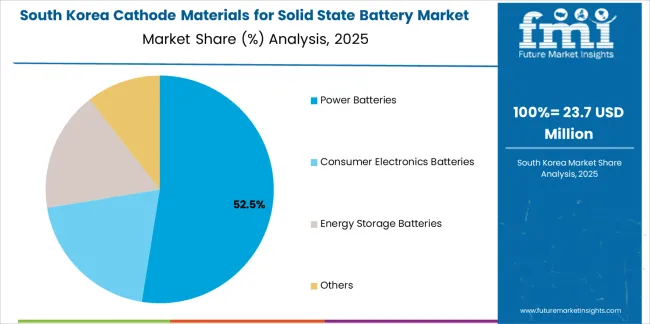
South Korean Cathode Materials for Solid State Battery operations reflect the country's advanced automotive capabilities and export-oriented technology development model. Major battery manufacturers including Samsung SDI and LG Energy Solution drive material procurement strategies for their production facilities, establishing direct relationships with specialized cathode material suppliers to secure consistent quality and performance for their battery programs and advanced electric vehicle systems targeting both domestic automotive markets and international collaboration projects.
The Korean market demonstrates particular strength in integrating cathode materials into next-generation battery platforms and advanced automotive configurations, with engineering teams developing solutions that bridge traditional battery applications and next-generation solid-state systems. This integration approach creates demand for specific performance specifications that differ from conventional applications, requiring suppliers to adapt material characteristics and electrochemical performance.
Regulatory frameworks emphasize automotive safety and battery performance reliability, with Korean automotive standards often exceeding international requirements for cathode materials. This creates barriers for standard material suppliers but benefits established manufacturers who can demonstrate automotive-grade performance capabilities. The regulatory environment particularly favors suppliers with Korean automotive qualification and comprehensive testing documentation systems.
Supply chain excellence remains critical given Korea's automotive focus and international collaboration dynamics. Battery manufacturers increasingly pursue development partnerships with suppliers in China, Japan, and specialized manufacturers to ensure access to cutting-edge cathode technologies while managing production risks. Investment in manufacturing infrastructure supports performance advancement during extended battery technology development cycles.
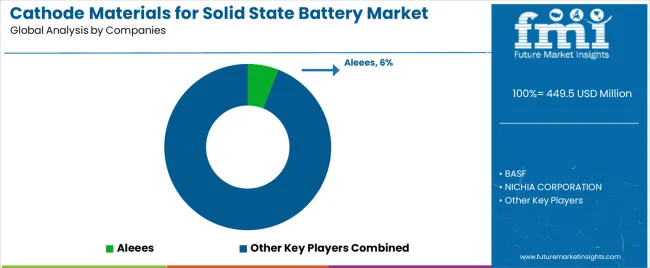
Profit pools are consolidating upstream in advanced material synthesis and downstream in application-specific solutions for electric vehicles, energy storage, and consumer electronics markets where electrochemical performance, cycling stability, and exceptional energy density capabilities command substantial premiums. Value is migrating from basic material production to specification-driven, application-ready cathode systems where crystal engineering expertise, precision synthesis, and reliable performance characteristics create competitive advantages.
Several archetypes define market leadership: established European chemical companies defending share through advanced material science and comprehensive application support; Asian battery material producers leveraging manufacturing scale and cost efficiency; American technology leaders with automotive expertise and precision manufacturing heritage; and emerging manufacturers pursuing specialized formulations while developing advanced synthesis capabilities. Switching costs - material qualification, battery integration, performance validation - provide stability for established suppliers, while technological advancement requirements and automotive application growth create opportunities for innovative manufacturers.
Consolidation continues as companies seek synthesis scale; direct automotive partnerships grow for specialized applications while traditional chemical distribution remains relationship-driven. Focus areas: secure electric vehicle and energy storage market positions with application-specific performance specifications and technical collaboration; develop cathode material technology and advanced manufacturing capabilities; explore specialized applications including aerospace and industrial energy storage requirements.
| Stakeholder Type | Primary Advantage | Repeatable Plays |
|---|---|---|
| European Chemical Leaders | Advanced material science; proven automotive relationships; established quality systems | Precision synthesis; technical innovation; application support |
| Asian Battery Material Producers | Manufacturing scale; cost efficiency; comprehensive production programs | Production scaling; technology advancement; market penetration strategies |
| American Technology Companies | Automotive expertise; precision manufacturing; trusted by major vehicle programs | Industry partnerships; application-specific specifications; technology collaboration |
| Emerging Technology Producers | Specialized formulations; competitive pricing; rapid development capabilities | Material innovation; production efficiency; niche market strategies |
| Chemical Distributors | Technical distribution networks; customer relationships; inventory management | Material expertise; supply chain management; technical support services |
| Item | Value |
|---|---|
| Quantitative Units | USD 449.5 Million |
| Type Segments | Lithium Cobalt Oxide; Lithium Iron Phosphate; High Nickel Ternary Materials; Others |
| Applications | Power Batteries; Consumer Electronics Batteries; Energy Storage Batteries; Others |
| End-Users | Electric Vehicle Manufacturers; Consumer Electronics Companies; Energy Storage Providers; Aerospace & Defense; Others |
| Voltage Rating Segments | Low Voltage; Medium Voltage; High Voltage; Ultra-High Voltage |
| Battery Capacity Segments | Below 50 Ah; 50-200 Ah; 200-500 Ah; Above 500 Ah |
| Distribution Channels | Direct Sales; Material Distributors; Technology Partners; System Integrators |
| Regions Covered | North America; Latin America; Europe; Asia Pacific; Middle East & Africa |
| Key Countries | China; India; Germany; Brazil; United States; United Kingdom; Japan (+35 additional countries) |
| Key Companies Profiled | Aleees; BASF; NICHIA CORPORATION; NEI Corporation; Umicore; Tianli Lithium Energy Group Co., Ltd.; Shenzhen Dynanonic Co., Ltd; Zhejiang Huayou Cobalt Co., Ltd.; Hunan Yuneng New Energy Battery Material Co., Ltd.; Xiangtan Electrochemical Technology Co., Ltd; Ningbo Ronbay New Energy Technology Co., Ltd.; Minmetals New Energy Materials (Hunan) Co., Ltd.; Xiamen Tungsten Corporation,Ltd.; Beijing Easpring Material Technology Co., Ltd.; BTR New Material Group Co.,Ltd; Guizhou Zhenhua E-Chem Inc.; Hunan Shanshan Energy Technology Co., Ltd.; Shengdong Technology Industry Co., Ltd.; Nantong Reshine New Material Co., Ltd. |
| Additional Attributes | Dollar sales by type and application; Regional demand trends (NA, EU, APAC); Competitive landscape; Direct vs. distributor adoption patterns; Manufacturing and battery system integration; Advanced material innovations driving energy density enhancement, cycling stability, and electrochemical performance excellence |
By Type
The global cathode materials for solid state battery market is estimated to be valued at USD 449.5 million in 2025.
The market size for the cathode materials for solid state battery market is projected to reach USD 5,604.2 million by 2035.
The cathode materials for solid state battery market is expected to grow at a 28.7% CAGR between 2025 and 2035.
The key product types in cathode materials for solid state battery market are lithium cobalt oxide, lithium iron phosphate, high nickel ternary materials and others.
In terms of application, power batteries segment to command 52.8% share in the cathode materials for solid state battery market in 2025.






Full Research Suite comprises of:
Market outlook & trends analysis
Interviews & case studies
Strategic recommendations
Vendor profiles & capabilities analysis
5-year forecasts
8 regions and 60+ country-level data splits
Market segment data splits
12 months of continuous data updates
DELIVERED AS:
PDF EXCEL ONLINE
Analyzing Cathode Binders Market Share & Industry Leaders
Cathode Battery Material Market
Nanomaterials Market Insights - Size, Share & Industry Growth 2025 to 2035
Tire Materials Market Insights – Size, Trends & Forecast 2025–2035
Facade Materials Market Size and Share Forecast Outlook 2025 to 2035
Solder Materials Market Size and Share Forecast Outlook 2025 to 2035
Sheath Materials Market Size and Share Forecast Outlook 2025 to 2035
Exosuit Materials Market Size and Share Forecast Outlook 2025 to 2035
Stealth Materials and Coatings Market Size and Share Forecast Outlook 2025 to 2035
Optical Materials Market - Trends & Forecast 2025 to 2035
Circuit Materials Market Analysis based on Substrate, Conducting Material, Outer Layer, Application, and Region: Forecast for 2025 and 2035
Battery Materials Recycling Market Size and Share Forecast Outlook 2025 to 2035
Battery Materials Market: Growth, Trends, and Future Opportunities
Graphite Materials Market Size and Share Forecast Outlook 2025 to 2035
Building Materials Market Size and Share Forecast Outlook 2025 to 2035
Recycled Materials Packaging Market Size and Share Forecast Outlook 2025 to 2035
Magnetic Materials Market Growth - Trends & Forecast 2025 to 2035
Fluoride Materials Market
Packaging Materials Market Size and Share Forecast Outlook 2025 to 2035
Strapping Materials Market Size and Share Forecast Outlook 2025 to 2035

Thank you!
You will receive an email from our Business Development Manager. Please be sure to check your SPAM/JUNK folder too.
Chat With
MaRIA